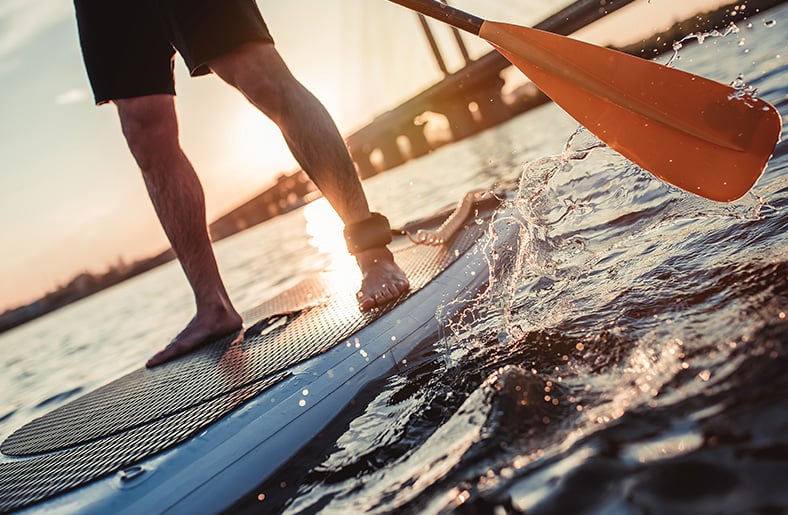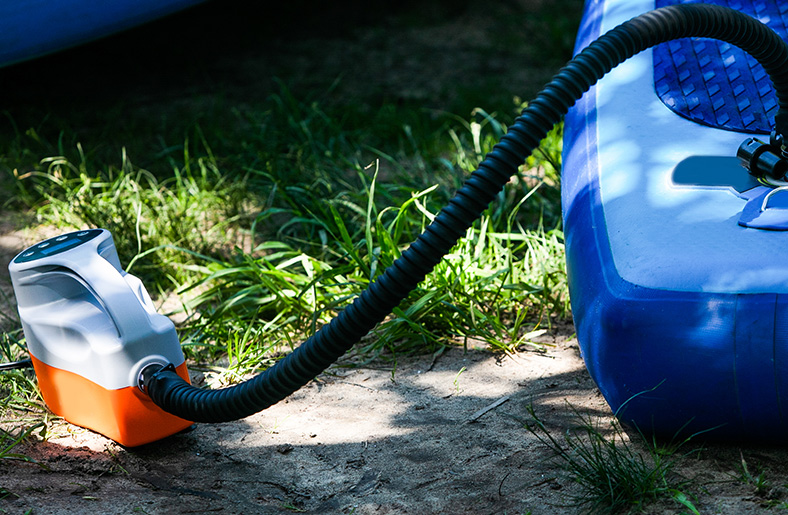Stand up paddle boarding — SUP for short — has quickly risen in popularity for good reason. Paddle boarding offers a mean workout, serves as a great stress reliever, and is an exciting way to learn something entirely new.
Before you can really get into this fantastic sport, though, you need to have the right gear. That starts with your very own paddle board.
Some folks get a paddle board first and then work out what they can use it for, but to get the most out of your stand up paddle board, it’s best to consider the most important factors in advance. PSI is a key part of that, so what PSI should an inflatable paddle board be?

Contents
First Things First: What Is PSI, Exactly?
PSI is a unit of pressure. It stands for pounds per square inch, and expresses how many pounds of force will be exerted on every square inch of the inside of your paddle board while it’s inflated.
A deeper dive into the meaning of PSI would get really mathy really quickly, and that’s not really necessary if you just want to enjoy paddle boarding.
It’s good to know, however, that most high-quality inflatable paddle boards have a PSI of 10 to 15, and that some can go up to and even beyond 20 PSI. Each paddle board’s manufacturer will have a recommended PSI, and it’s important to stick to that.
Do not to overinflate the paddle board, causing more pressure to be exerted than it was designed for. By the same token, it’s equally crucial not to underinflate the board, making it floppy and rendering it rather unstable in the water.
Likewise, keep in mind that excess pressure will escape through the valve — but if you really overdo it, that valve won’t cut it and you run the risk that the pressurized air will escape through your board’s weak points, instead. Yes, by essentially bursting it open. That’s why we always pay attention to the recommended PSI!

How Does an SUP’s PSI Influence its Performance in the Water?
As you decide what kind of PSI you’d like from your new paddle board, you’ll need to know how this metric will impact the day-to-day performance of your paddle board in the water. Generally speaking:
- Higher PSI — meaning more pressure — means that your SUP is going to be more stable. That’s often a very desirable feature for people who are new to stand up paddle boarding!
- With a slightly lower PSI, on the other hand, paddle boarders become more maneuverable.
- If your inflatable paddle board’s chamber doesn’t have enough PSI, in which case you have not inflated it to the manufacturer’s recommendations, the paddle board will have more slack in the middle. You’ll sink into the paddle board while you’re out on the water, which can make you far less stable.
- Heavier paddle boarders will want to shoot for the upper end of the recommended PSI on a paddle board, because they’ll themselves exert more pressure on the board.
- A lower PSI paddle board is optimal for people who want to maneuver themselves through the water. A higher PSI paddle board is best for those who are mainly hoping to engage in more stationary activities like SUP fishing or SUP yoga.

What’s the Best PSI for a Paddle Board?
For most paddle boarders, who are hoping to achieve a feel similar to what they’d get from a rigid paddle board but also want flexibility, a board with a PSI between 12 to 15 is the way to go.
Very high PSI paddle boards, with a PSI between 18 and 20, are on the market — but they’re mostly designed for pro paddle boarders or those who, for one reason or another, need extreme rigidity.
Let’s take a look at some of the most popular high-quality inflatable paddle boards on the market to illustrate this point:
- iRocker recommends a PSI of 15, while these paddle boards can be inflated up to 23.
- Redpaddleco boards have a recommended PSI of 15 to 22, while this manufacturer advises heavy paddle boarders to inflate their boards to a PSI of 25.
- Bluefin boards have a PSI of 12 to 25. This manufacturer specifies that 12 to 15 PSI is great for general use, while a PSI of 15 to 18 is recommended for the cruiser range.
- Itiwit advises paddle boarders to inflate their SUPs to a PSI of 15 to 17.
Most of these popular paddle boards — and others — can be inflated to higher PSIs, but that should only be done if the rider is heavier or the temperature outside is very hot. Most general use paddle boarders won’t see any special advantages if they inflate their paddle boards to a PSI higher than 15, so we’ll just go ahead and say that a PSI of 15 is the best for most folks.

Inflating a Paddle Board to the Correct PSI
Stand up paddle boarding makes for a wonderful workout, and you’re probably excited to dive right in. If you look around the internet, it’s not hard to find people who share that inflating their high PSI paddle boards is a workout all on its own, though — and that’s likely an ordeal you’d rather skip.
If, for some reason, you choose a very high PSI paddle board, you’ll at the very least need a high pressure pump to inflate it. An electric pump is the better choice in this case, though, if you want to save your workout for when you actually get onto the water!
In other words, choosing a high PSI paddle board likely means choosing to buy an expensive pump, too, so just keep that in mind as you’re budgeting.
A Final Word
An inflatable paddle board should generally have a 10 to 15 PSI. Heavier riders and those who value stability over all else may want to go with a board that recommends a PSI of 20 or even higher, but by choosing a high PSI board, you do lose a great deal of flexibility.

